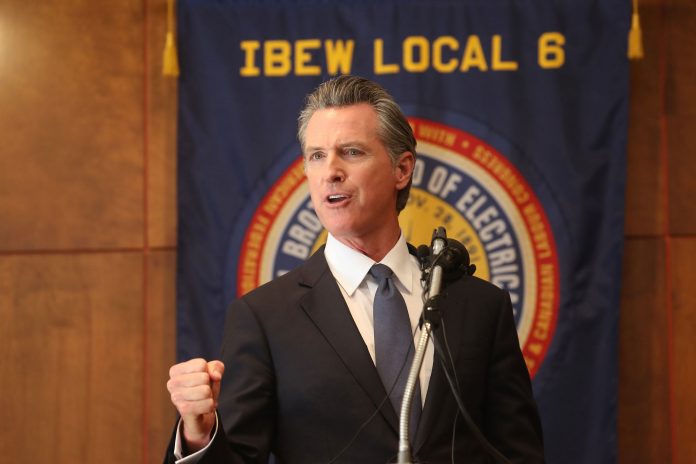
SACRAMENTO — California voters will decide whether to recall Gov. Gavin Newsom on Tuesday, concluding an idiosyncratic election that has been held in the middle of a pandemic and closely watched as one of the first big indicators of the country’s political direction since President Joe Biden took office.
Democrats feel increasingly confident, predicting that Newsom will prevail and avert what would be a disaster for the party in California, the nation’s most populous state. If Newsom is recalled, his likely replacement would be Larry Elder, a conservative talk radio host who has made a career bashing liberal causes.
But the fact that the Democratic governor of a state that Biden won by nearly 30 percentage points is being forced to fight to hold on to his post has highlighted the vulnerabilities of leaders who seemed well positioned before the coronavirus pandemic.
Democrats are trying to energize voters without former President Donald Trump on the ballot, and a loss — or even a narrow victory — would raise questions about the political clout of Biden, who campaigned with Newsom on Monday night.
The leading Republicans vying to replace Newsom have embraced Trump and his baseless claims of a stolen election, an early signal of the party’s unwillingness or inability to distance itself from the former president. On Tuesday, the red versus blue polarization of both the recall campaign and of California itself was evident as voters headed to the polls across the state.
“We’ve gotten a governor out of office before — we can do it again, and we should do it again,” said Sue Vonidstein, 61, a former business owner who voted to support the recall in one of the most conservative parts of Orange County.
Miles away, in another part of the county, Candice Carvalho, 42, cast her ballot against the recall.
“I thought it was important to show that Orange County isn’t just Republicans,” Carvalho said, adding of the recall, “It was a waste of money and completely unnecessary. And I’m a little shocked we’re focusing on this now.”
Even if the peculiar nature of California’s recall elections does not offer a perfect barometer of the national mood, much is at stake, including the leadership of the world’s fifth-largest economy. Political insiders in both parties note that Newsom’s fate could have far-reaching national consequences, given the governor’s power to appoint a new senator should a vacancy arise.
Voters are being asked two questions: Should Newsom be recalled? And if that happens, who should replace him? Forty-six candidates, about half of them Republican, are on the ballot, along with seven certified write-in candidates.
The winner will serve out the remainder of Newsom’s term, which ends in January 2023. Regardless of the outcome, there will be another election in a little over a year.
When will the polls close?
Polls close at 8 p.m. Pacific time. Depending on the number of early ballots and the amount of in-person voting Tuesday, the math could be clear within a few hours of when the polls close, election experts say. But if the race is tighter than expected, weeks could pass while the counting drags on.
Here’s what we’re watching as the results are released.
Will the governor survive the recall?
Early returns suggest that California’s huge Democratic base is rallying for Newsom, who was elected in 2018 in a landslide. The governor’s campaign has framed the recall as a power grab by Trump Republicans.
If Newsom is recalled, it will have been because a critical mass of independent voters and Democrats voted against him, which in California would suggest a significant — and improbable — shift to the right.
The more likely question is whether the governor wins by a wide or a narrow margin. For a time, polls seemed to indicate that likely voters were unenthusiastic about Newsom, which triggered a torrent of support from major donors and appearances by national Democratic figures, including Biden.
A decisive win by Newsom, as some recent polls predict, would strengthen him heading into a campaign for a second term in 2022 and perhaps even position him for national office. But if Newsom prevails by only a couple of percentage points, he could face a primary challenge next year.
How many Republicans will cast ballots?
Republicans represent only a quarter of California’s registered voters. Since the 1990s, when the party’s anti-immigrant stances alienated Latinos, their numbers have been in decline. Proponents have presented the recall as a way to check the power of Democrats, who control all statewide offices and the Legislature. Republicans also say the battle has animated their party’s base.
But Republican support and money for the recall have failed to approach Newsom’s large operation and campaign funding. And Elder’s candidacy appears to be further branding the GOP as far-right by California standards. Support for moderates like Kevin Faulconer, the former mayor of San Diego, is in the single digits, polls indicate.
Critics of the GOP under Trump say a failure to remove Newsom could further diminish Republican influence in California and accentuate the nation’s polarization.
How will Latinos vote?
Latinos are the largest ethnic group in California, making up roughly 30% of registered voters — a largely Democratic constituency that has shaped the state’s governance for decades.
But to the consternation of Newsom’s party and the great interest of the recall backers, Latinos have been slow to weigh in on his ouster, thanks to a combination of distraction — many voters are more focused on navigating the pandemic — and ambivalence, both about Newsom specifically and the Democratic Party as a whole.
Critics have warned that California Democrats have unwisely assumed that the Latino electorate would be animated by memories of Republican anti-immigrant policies, rather than trying to woo Latinos with their vision for the future.
That has stirred speculation over whether the fast-growing Latino vote, in California and elsewhere, may be up for grabs by candidates willing to put in the work to engage those voters. After Republicans peeled away significant amounts of Latino support across the country during the 2020 election, a poor showing by Latino voters in the recall could spark a new round of Democratic soul-searching.
How influential will mail-in ballots be?
Every registered, active voter in California was sent a ballot in an extension of pandemic voting rules. Initiated in 2020 to keep voters and poll workers safe, the system helped boost turnout to more than 70% in the presidential election. This month, lawmakers voted to make the system permanent.
California election officials say voting ran smoothly in 2020. But Republicans have contended that mailed-in ballots invite cheating, echoing Trump’s baseless claim that Democrats had used them to steal the presidential election.
Last week, in an appearance on Newsmax, the former president claimed without evidence that the recall election was “probably rigged.”
Conservative groups seeking evidence of voter fraud have been asking Californians to alert them to recall ballots that arrive in the mail addressed to deceased people or to voters not residing at their address.
The warnings about voting by mail appear to have had an effect: Republicans have proved themselves reluctant to embrace the practice — a trend that worries some in the party as more states adopt mail-in balloting. Still, the night before the election, almost 40% of all registered voters had already cast their ballots, a hefty share that suggests the ease of voting early and by mail will enhance turnout in what is an unusually timed special election.
That bodes well for Newsom, who is relying on the state’s enormous base of Democratic voters: The greater the overall turnout, his campaign says, the better his chances.
Still, analysts are watching to see whether significant numbers of Republican voters vote in person Tuesday, and whether younger and Latino voters will join them.
What will the vote say about pandemic policies?
Had COVID-19 not set the stage, Newsom arguably would not be fighting for his job now. But lately, he has progress to report. Cases have declined this month in California, where wearing face masks indoors has become a fact of life in many places, and some 80% of eligible people have gotten at least one vaccine dose.
In recent weeks, Newsom has trumpeted California’s approach, noting that mask and vaccination requirements have lowered new cases to half of the rates reported in Republican-run states.
Californians have said no issue matters more to them than conquering the coronavirus. Broad support for Newsom, beyond Democratic voters, could signal to policymakers elsewhere — including in some of the dozens of other states with governors’ races next year — that strong health policies can be good politics.
Other Democratic candidates on the ballot this fall have also leaned into policies like mask and vaccine mandates while raising alarms that their Republican opponents would undo those measures. Biden has followed suit, offering stricter policies around mandates and tougher talk aimed at Republican governors.
How will Trump affect the race?
For four years, Democrats enjoyed enormous gains thanks to Trump. The former president energized party activists, helped their candidates raise mountains of campaign cash and drove their voters to the polls in record numbers.
Newsom has tried to sustain that source of inspiration, offering frequent warnings about the continuation of “Trumpism” in American political life. His recall election offers the first major test of whether the specter of the former president still has the power to mobilize liberal voters while keeping moderates voting Democratic.
On the Republican side, the leading candidates have embraced Trump’s political playbook, offering baseless allegations of election fraud and “rigged” votes. Elder has refused to say if he will accept the results of the election.
Not all Republicans agree with this playbook. Some worry it could cause some Republicans to stay home because they believe their votes will not count, and low turnout could lend credence to that argument.
This article originally appeared in The New York Times.
Copyright 2021 The New York Times Company













